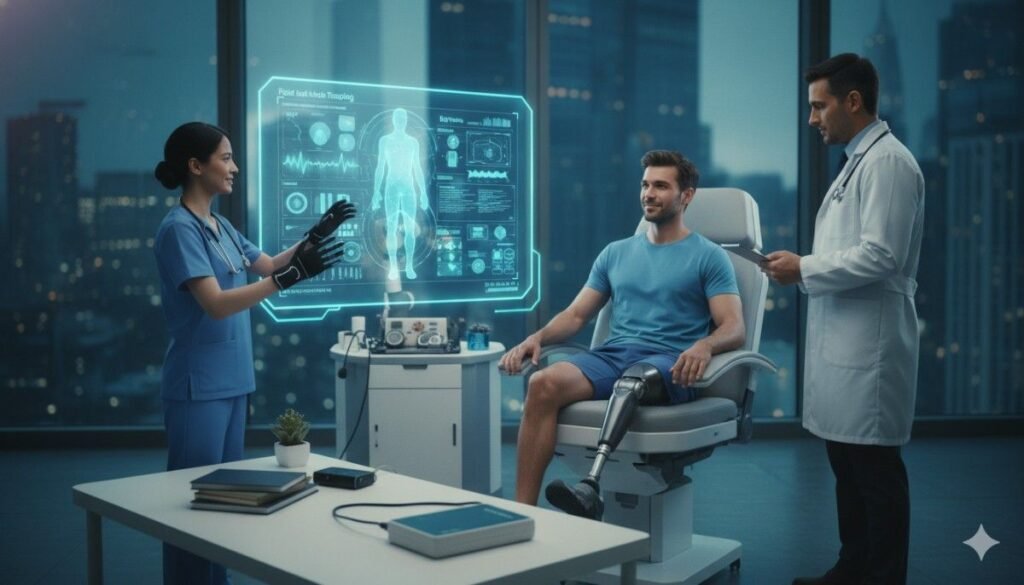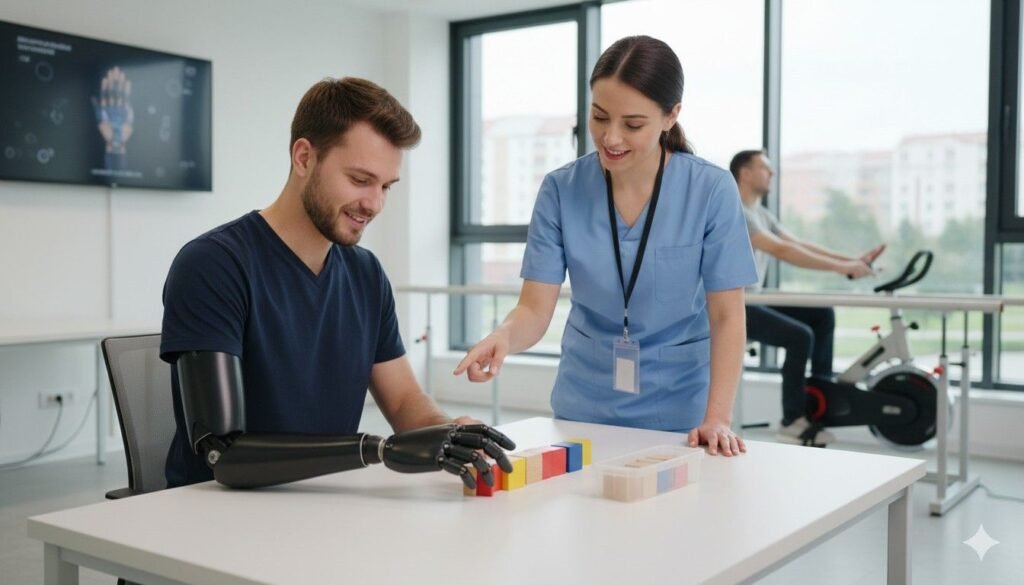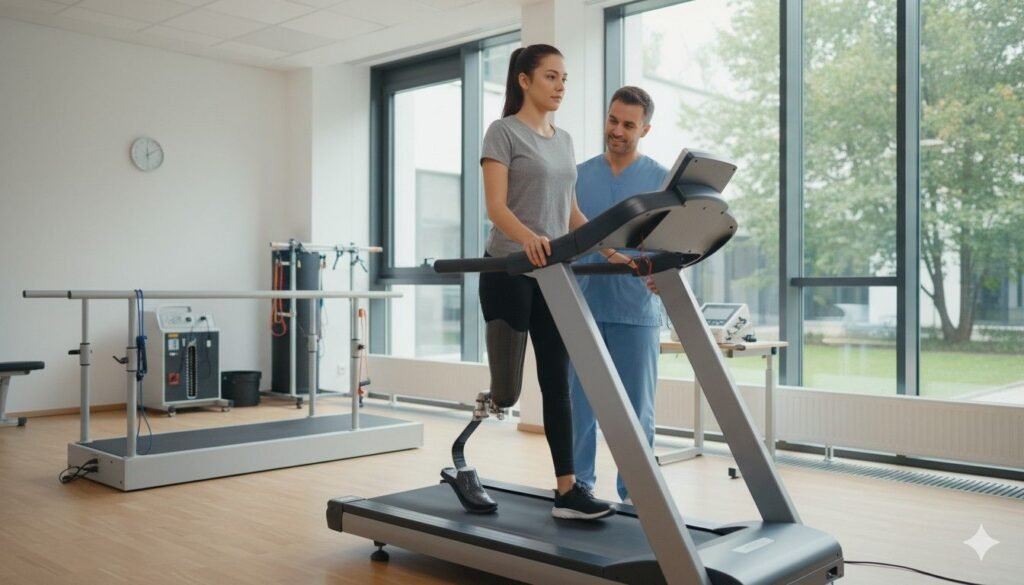Accepting a prosthesis is not only a physical process.
It is also an emotional journey filled with hope, fear, questions, and uncertainty.
Clinicians today have a powerful tool to support patients through this journey: data.
When used thoughtfully, outcome data helps patients understand their progress, trust their abilities, and feel more confident with every step they take.
It turns confusing improvements into clear evidence, and it gives both the clinician and the patient a shared language for success.
Why Data Matters in Prosthetic Acceptance
How Data Helps Patients Understand Their Own Progress
Many patients cannot feel small improvements in their movement.
Walking may still feel uneven or tiring, even when they are actually getting stronger.
When clinicians show simple numbers—like faster TUG times or longer 6MWT distances—patients finally see proof of progress.
This proof reduces self-doubt and helps them believe that the prosthesis is working for them, not against them.
Why Data Builds Trust Between Patient and Clinician
Patients often feel overwhelmed in the early stages of rehab.
They wonder if their struggles are normal or if they are “behind.”
When clinicians use data to explain what is improving and why, it builds trust.
Clear evidence helps patients feel guided, supported, and understood.
How Data Makes the Journey Less Emotional and More Structured
Amputation brings many emotions that can cloud a patient’s perception of success.
Data helps separate feelings from facts.
It creates a calm, steady structure that patients can rely on when emotions rise.
This structure brings clarity to a journey that often feels unpredictable.
Using Outcome Measures as Counseling Tools
How Clinicians Use AMP Scores to Explain Mobility Potential

The AMP score shows how well a patient can balance, shift weight, and control early movements.
During counseling, clinicians use AMP to explain the patient’s starting point in a simple way.
It helps patients understand what their body can do now and what it can learn to do next.
This sets realistic expectations and reduces fear.
How TUG Times Help Patients See Improvement in Everyday Tasks
TUG time reflects how quickly a patient can stand, walk, turn, and sit again.
Clinicians use this in counseling sessions to show how daily tasks are getting easier.
Even a few seconds of improvement can mean safer walking at home or smoother turning in a small room.
These small wins strengthen acceptance because they feel practical and relatable.
Why 6MWT Results Strengthen Belief in Long-Term Possibility
The six-minute walk distance shows the patient’s overall endurance.
When clinicians share this number during counseling, it helps patients imagine life beyond rehab—like returning to work, school, or outdoor activities.
Seeing endurance grow gives them hope for a future with more freedom.
Hope is a powerful driver of acceptance.
Helping Patients Understand What “Normal Progress” Looks Like
Using Data to Show That Progress Is Not Linear
Patients often expect progress to move in a straight line.
When they hit plateaus, they fear something is wrong or that the prosthesis won’t work for them.
Data helps clinicians explain that slower phases are normal and usually temporary.
This reassurance keeps motivation stable during difficult weeks.
Explaining Why Some Weeks Show Bigger Gains
Sometimes AMP or TUG scores rise quickly, while other times they barely move.
Clinicians use data to explain why the body adapts at different speeds.
Patients learn that progress depends on strength, comfort, and emotional readiness.
Understanding this prevents frustration and builds patience.
Showing How Long-Term Trends Matter More Than Daily Feelings
Daily performance changes with mood, sleep, or fatigue.
Data helps patients see patterns over weeks instead of focusing on one tough day.
This broader view helps them trust the process.
A long-term pattern of improvement is easier to believe when it is clearly visible.
Using Data to Address Fear and Doubt
Helping Patients Feel Safe With Clear Evidence
Many patients fear falling or hurting themselves.
When clinicians show that balance scores or step symmetry are improving, patients feel safer.
They begin trusting the prosthesis as part of their body rather than something separate.
Safety is a foundation of acceptance.
Using Data to Replace Self-Criticism With Self-Understanding
Some patients blame themselves for slow progress.
Data helps clinicians explain what is actually happening—whether it is limb volume changes, muscle fatigue, or simple fear.
This shifts the conversation from blame to understanding.
Understanding lowers emotional pressure and encourages steady effort.
Showing Patients That Their Effort Makes a Difference
Data reveals how consistent practice leads to measurable gains.
When patients see improvement, they feel proud of their effort.
This pride strengthens their relationship with their prosthesis.
Effort feels meaningful when the results are visible.
How Data Supports Shared Decision-Making
Guiding Conversations About Component Choices
Patients often feel confused when choosing liners, feet, or hands.
Clinicians use outcome data to explain how each component affects mobility.
When patients see numbers that support the recommendation, they feel more confident in the decision.
Data turns confusing decisions into informed choices.
Helping Patients Understand When Adjustments Are Needed
Sometimes a socket needs modification or alignment changes.
Data—like slowing TUG times or reduced wear time—helps clinicians explain why.
Patients understand that the issue is mechanical, not personal.
This removes shame and builds acceptance of necessary changes.
Creating a Partnership Instead of a One-Way Instruction
Data makes the relationship between clinician and patient more equal.
Both sides look at the same numbers, discuss the same trends, and set the same goals.
This shared approach increases commitment and reduces resistance.
Patients accept the prosthesis more easily when they feel included.
How Data Helps Clinicians Personalise Counseling
Using Data to Identify Emotional Barriers

If scores improve but the patient feels stuck, clinicians know the barrier is emotional—not physical.
This insight helps them shift counseling toward fear, confidence, or expectations.
Data reveals what the patient may not be able to express openly.
Personalized counseling becomes more precise and compassionate.
Matching Goals to the Patient’s Lifestyle
Clinicians use outcome data to tailor goals to the patient’s real world—not an idealized one.
If endurance improves, they may encourage outdoor walking.
If balance improves, they may introduce stairs or uneven surfaces.
This practical approach makes rehabilitation feel relevant.
Showing Patients That Their Path Is Unique
Patients often compare themselves to other amputees.
Data helps clinicians show that everyone starts from a different point and moves at a different pace.
They learn that their progress is valid and meaningful, even if it looks different.
This protects their confidence and reduces unnecessary pressure.
How Data Strengthens Long-Term Prosthetic Acceptance
Showing Patients Their Progress in Real-World Activities
Acceptance grows when patients see how their prosthesis helps in daily life.
Outcome data makes this visible.
A stronger 6MWT score may mean they can walk to the market without stopping.
A better TUG time may mean they can move around the kitchen without fear of losing balance.
Clinicians can translate numbers into real scenarios, helping patients connect their effort with practical freedom.
Helping Patients Believe They Can Do More Than They Thought
Most amputees underestimate their potential after surgery.
They fear pain, instability, or embarrassment.
Data helps clinicians show them, in simple terms, that their bodies are capable of more than they imagine.
Seeing the numbers rise gives patients the courage to attempt new tasks, which deepens acceptance.
Reassuring Patients When They Feel Stuck
There are weeks when a patient feels like nothing is improving.
Emotions can cloud their view of progress.
When clinicians pull up long-term graphs and show steady improvement, it calms the patient.
This quiet reassurance helps them stay committed during slow phases of recovery.
Using Data to Strengthen Family Counseling
Helping Families Understand the Patient’s Progress
Family members often have their own expectations—sometimes too high, sometimes too low.
Outcome data gives them a realistic picture.
They can see that progress is happening, even if it looks slow day to day.
This prevents misunderstandings and reduces pressure on the patient.
Showing Families How Their Support Helps
When clinicians show improvement in balance, step count, or confidence, families understand how their encouragement contributes.
This creates a sense of teamwork at home.
Families become more patient and more involved.
Supportive families make acceptance much easier.
Helping Families Adjust Their Expectations
Sometimes families expect instant independence.
Data helps educate them that recovery is gradual and unique for each person.
This realistic framing protects the patient from feeling rushed or judged.
Balanced expectations build a healthier recovery environment.
Making Data a Part of Every Rehabilitation Conversation
Starting Each Session With a Quick Review

Clinicians can begin each counseling session by reviewing one or two simple numbers.
This sets a positive tone and keeps patients aware of their progress.
Over time, patients learn to understand their own data.
This builds confidence and deepens engagement in rehabilitation.
Connecting Each Exercise to an Outcome
When patients know why they are doing a specific task, they give more effort.
Clinicians can say, “This exercise improves the score that helps you turn quickly or step safely.”
This makes rehab feel useful rather than exhausting.
Purpose turns effort into motivation.
Using Data to Plan What Happens Next
Outcome trends guide decisions about when to progress, when to pause, and when to adjust.
Clinicians can show patients the data and explain the plan clearly.
This sense of direction reduces anxiety and builds trust.
Clear plans make acceptance smoother.
How Data Supports Tele-Rehab Sessions
Using Videos to Track Gait Changes Over Time
Patients can send short walking videos during tele-rehab.
Clinicians observe foot placement, step length, and hip movement.
They can compare these videos to earlier ones and show improvement directly.
This visual evidence reassures patients who cannot visit the clinic often.
Monitoring Wear Time and Step Count Through Simple Tech
Wearable devices or smartphone apps show how long a patient uses the prosthesis and how much they walk.
These numbers help clinicians understand daily habits.
If wear time rises steadily, it signals growing acceptance.
Data becomes a bridge between home life and clinical decision-making.
Conducting Simple Tests Remotely
Patients can perform basic standing tests, sit-to-stand tasks, or small walking drills on camera.
Clinicians can score these and track improvements over time.
This brings structure to tele-rehab and reduces the fear of “doing things wrong” at home.
Clear remote feedback supports long-term acceptance.
How Clinicians Use Data to Spot Emotional Drop-Off Points
Identifying When the Patient Is Losing Motivation
If step count drops or wear time decreases, it may signal that the patient is discouraged.
Clinicians can use these numbers to open gentle conversations.
They can explore whether pain, fear, or fatigue is causing the decline.
This early detection prevents emotional withdrawal from rehab.
Catching Signs of Avoidance
Some patients avoid activities that feel unsafe—like turning, carrying objects, or walking outdoors.
Data helps clinicians identify avoidance patterns even before the patient mentions them.
This enables counseling that focuses on safety and rebuilding confidence.
Understanding avoidance helps prevent long-term fear.
Recognizing When the Patient Needs a New Goal
When progress slows for too long, patients may feel bored or hopeless.
Data helps clinicians recognize this early.
Setting a new, meaningful target can reignite motivation.
Well-timed goals help maintain emotional engagement.
Using Data to Build Stronger Clinical Conversations
Turning Data Into Simple Language

Numbers can confuse patients if not explained well.
Clinicians must translate scores into everyday meaning:
“This improvement means you can walk farther without resting.”
“This change means you are more stable when turning.”
Simple language helps patients feel informed without feeling overwhelmed.
Using Data to Validate the Patient’s Experience
Sometimes patients worry that they are not improving.
When clinicians show slow but steady gains, the patient feels seen.
Validation reduces worry and increases acceptance.
It strengthens trust in the rehabilitation process.
Using Data to Navigate Difficult Topics
It can be challenging to tell a patient that progress is slower than expected.
Data makes these conversations more honest and less emotional.
Clinicians can explain what needs adjusting and how to get back on track.
This keeps communication respectful and constructive.
The Role of Data in Supporting Prosthesis Choice and Satisfaction
Helping Patients Compare Options Objectively
Choosing between feet, knees, or hands can be overwhelming.
Data helps clinicians show how different components affect step length, balance, or energy use.
Patients feel more confident in their choices.
Confident decisions lead to smoother acceptance.
Showing Patients What the Prosthesis Is Capable Of
When patients see how quickly their scores improve, they understand the true potential of their device.
This increases satisfaction and reduces doubt.
It reassures them that they made the right choice.
Belief in the device strengthens commitment to using it.
Helping Identify When a Change in Components Is Needed
If data shows a sudden drop in performance, clinicians can evaluate whether the current component still suits the patient.
This makes adjustments timely and evidence-driven.
Timely changes protect confidence and comfort.
Data as a Tool for Long-Term Retention and Success
Keeping Patients Connected Even After Formal Rehab Ends
Many patients stop using their prosthesis consistently after discharge.
Data helps clinicians keep track through periodic check-ins.
This keeps motivation alive and prevents decline.
Long-term acceptance depends on ongoing support.
Helping Identify Early Signs of Regression
If step count or gait quality decreases in the months after rehab, it often signals pain or fear.
Clinicians can address issues before they become serious.
This prevents abandonment of the prosthesis.
Early intervention saves time and protects mobility.
Motivating Patients to Stay Active
Data shows patients that they are improving even long after formal therapy ends.
This encourages them to maintain daily activity and keep setting new goals.
Long-term activity builds confidence and lifelong acceptance.
Final Section: Building a Future Where Data Makes Rehabilitation More Human
Data Makes Care More Compassionate

Many people assume data makes care feel cold or technical.
But in prosthetic rehabilitation, the opposite is true.
Data helps clinicians understand patients better, support them more personally, and guide them more gently.
It brings meaning to every small step forward.
Data Builds Stronger Partnerships Between Doctor and Patient
When both sides look at the same numbers, decisions become shared and respectful.
Patients feel empowered rather than pressured.
They understand what is happening in their bodies and why each step matters.
This partnership creates trust—an essential part of acceptance.
Data Helps Patients Believe in Themselves Again
Amputation can shake a person’s sense of identity.
Data shows them that progress is happening, even on hard days.
It helps them rebuild confidence and see their prosthesis as a path to a full, independent life.
This belief is the foundation of true prosthetic acceptance.
Conclusion
Prosthetic acceptance is not built in a single moment.
It grows slowly—step by step, test by test, conversation by conversation.
And data plays one of the most powerful roles in shaping this journey.
For many patients, seeing their own progress clearly for the first time becomes the moment their fear softens, their confidence rises, and their sense of possibility returns.
Outcome data takes something that once felt confusing and turns it into a map.
It helps patients understand what their body is doing, how it is adapting, and where it is heading.
Instead of relying on emotion alone, they can rely on numbers that reflect real change.
This gives them permission to trust themselves again—to believe that they can stand, walk, climb, and eventually live freely with their prosthesis.
For clinicians, data is not just a tool for measurement.
It is a tool for empathy.
It helps them explain progress gently, guide decisions wisely, and support patients with compassion.
Data reveals the patient’s fears, strengths, hesitations, and motivations long before they are spoken aloud.
It shows when pain is rising, when confidence is falling, when motivation is slipping, and when the patient is ready to move to the next level.
By using AMP, TUG, 6MWT, and other simple measures, clinicians can turn rehabilitation into a shared journey rather than a one-sided process.
Patients are no longer passive recipients of care—they become active partners who understand their goals and participate with purpose.
This shared language of data deepens trust and reduces the emotional weight that often slows progress.
Data also strengthens clinical decisions.
It guides socket adjustments, training progression, safety interventions, and long-term planning.
It helps clinicians catch hidden problems early, preventing complications that could derail both comfort and confidence.
It makes communication with families easier, clearer, and more supportive.
It even strengthens the clinic’s documentation, referrals, and professional standards.
But perhaps the greatest gift of data is hope.
Every improvement—no matter how small—becomes visible.
A few more meters walked, a few seconds shaved off a turn, a smoother balance shift, a longer standing time… these moments show patients that life is expanding again.
They show that independence is not only possible but already growing inside them.
In a world where amputation can leave a person feeling lost, outcome data becomes a gentle guide.
It gives structure to uncertainty, meaning to effort, and direction to the future.
It transforms rehabilitation from a difficult path into a hopeful journey, led by clarity instead of confusion.
When clinics use data not just to measure but to counsel, encourage, and empower, prosthetic acceptance becomes more than a goal—it becomes a natural result of feeling understood, supported, and seen.



